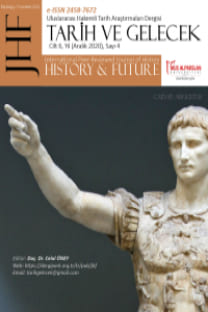Pers Kralı II. Kyros’un (Büyük Kyros) (M.Ö. 559-530) Soyağacı, Ailesi ve İsmi
Persler çeşitli boylardan oluşmaktadır ve bu boylardan en soylu olanı Pasargadaiboyudur. Pers kralları bu boyun kollarından biri olan ve liderliğini Akamenes’in/Ahameniş’in yaptığı boydan gelmektedir. Mevcut bilgiler Akamenid hanedanının tarihisüreçte iki kola ayrıldığını ve II. Kyros’un soyağacının sırasıyla I. Kambises, I. Kyros,Teispes ve Akamenes’e dayandığını göstermektedir. Antikçağ yazarları II. Kyros’un anne vebabası hakkında birbirinden farklı bilgiler vermektedir. II. Kyros’un kardeşi veya kardeşleriolup olmadığı konusunda arkeolojik ve epigrafk belgelerde ve antik dönem yazarlarınıneserlerinde herhangi bilgi bulunmamaktadır. Eldeki veriler II. Kyros’un Casandane ileevliliğinden Kambises ve Bardiya/Smerdis isimlerinde iki erkek, Atossa ile Artystoneisimlerinde ise iki kız çocuk sahibi olduğunu göstermektedir. Mevcut kaynaklar Kyrosisminin köken olarak Persçeye dayandığına dair bazı ipuçları vermektedir. Kyros ismininkaynaklarda “Güneş” anlamına geldiği önerilmektedir. Bunların yanı sıra Kyros ismininyalnızca bir insan ismi olarak kullanılmayıp Antikçağ’da ırmak, ova ve şehir ismi olarak dakullanıldığı görülmektedir.
Anahtar Kelimeler:
II. Kyros, Büyük Kyros, Akamenid Hanedanı, Persler, Pers İmparatorluğu, Eski İran
Genealogy, Family and Name Of The Persian King Cyrus II (Cyrus The Great) (559-530 B.C.)
The Persians consisted of several phratries and one of the most deep root phratrieswas regarded as the Pasargadai. Persian kings were drawn from these phratries whose leaderwas Achaemenes/Haxāmaniš. The present research indicates that the Achaemenid dynastywas divided into two branches and the family tree of Cyrus II consisted respectively of thesefollowing kings: Cambyses I, Cyrus I, Teispes and Achaemenes. Ancient authors providevery different information about Cyrus II’s mother and father. Neither in archeologicalor epigraphical documents nor in works of ancient authors, contain any information asto whether Cyrus II had had siblings. The documents show that Cyrus II had two sons(Cambyses and Bardia/Smerdis) and two daughters (Atossa and Artystone) through hismarriage with Casandane. There are some clues which show that the origin of Cyrus comesfrom Persian. It is argued that the textuak record supports the view that the name of Cyrushas an etymology related to “Sun”. Furthermore, it is possible to see that the name Cyrus isused as a geographical name for a river, a plain and a city.
Keywords:
Cyrus II, Cyrus the Great, Achaemenian Dynasty, The Persians, The Persian Empire, Ancient Iran,
___
- Waters, Matt, Parsumas, Ansan, and Cyrus, Elam and Persia, (Edited by: Javier ÁlvarezMon and Mark B. Garrison), Eisenbrauns, Winona Lake, Indiana 2011, s. 285-296.
- Yayın Aralığı: Yılda 4 Sayı
- Başlangıç: 2015
- Yayıncı: Celal ÖNEY
Sayıdaki Diğer Makaleler
II. Meşrutiyet Dönemi Mizah Gazeteciliğine Bir Örnek: Eşek Gazetesi
Pers Kralı II. Kyros’un (Büyük Kyros) (M.Ö. 559-530) Soyağacı, Ailesi ve İsmi
Roma Ordusunda Beslenme Düzeni
Münşeât Mecmuâlarının Tarihi Gelişimi Ve Râmi Mehmed Paşa’nın “Hulâsa-i İnşâ” İsimli Eseri
Göreleli Rüstemzâde Abdülhamid’in Mektuplarında Askerlik Ve Sosyal Hayat (1918- 1921)
Deniz Kavimleri Hareketinde Kuraklık Teorisi Sorunu
Yeni İpek Yolu Stratejileri Ve Trans-Avrasya Güvenlik Sistemleri
Kamame Kilisesi’nde Org Tartışmaları ve Katolikler
(H.1252/M.1836) Yılı Nüfus Sayımına Göre Van Kazasına Bağlı Gayrimüslim Köylerin Demografk Yapısı
